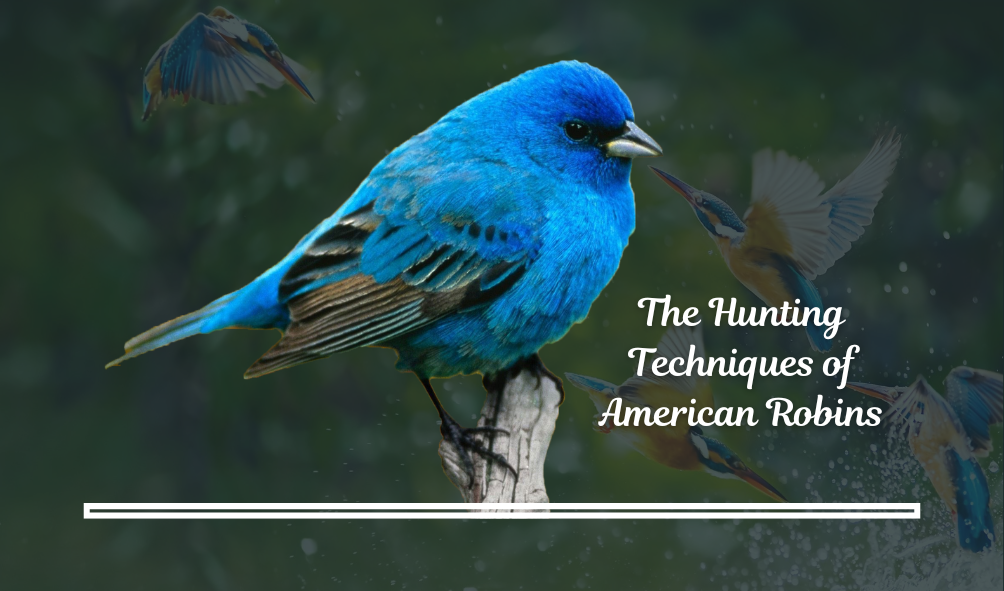Discovering How American Robins Locate Insects for Breakfast
American robins are well-known for their early morning activity, especially when it comes to searching for their first meal of the day. A common question arises about their ability to locate insects on the ground effectively. To understand this, we consulted with avian experts for a deeper insight.
Techniques Used by Robins to Find Insects
Experts explain that American robins utilize a combination of sight and sound to detect their prey. Their keen eyesight allows them to spot insects from a distance, even in the dim light of early morning. Additionally, robins have a highly developed sense of hearing which enables them to hear insects moving within the grass or soil.
The Role of Robins’ Vision and Hearing
Robins have a particular adaptation in their eyes that gives them excellent peripheral vision. This adaptation helps them to monitor slight movements on the ground as they forage. Their hearing complements their vision by picking up subtle sounds produced by insects, such as those moving underground or under leaves.
By using these advanced sensory skills, American robins can efficiently find and capture insects, providing them with the necessary energy to start their day. This fascinating aspect of robin behavior not only highlights their adaptation to their environment but also their skill as predators in their ecosystem.
Read more: The Role of Robins’ Vision and Hearing
Understanding these methods enhances our appreciation of the complexities of avian life and their survival strategies.
Discovering How American Robins Locate Insects for Breakfast
Exploring the Feeding Behavior of American Robins
American robins are well-known for their early morning activity, especially when it comes to searching for their first meal of the day. A common question arises about their ability to locate insects on the ground effectively. To understand this, we consulted with avian experts for a deeper insight.
Techniques Used by Robins to Find Insects
Experts explain that American robins utilize a combination of sight and sound to detect their prey. Their keen eyesight allows them to spot insects from a distance, even in the dim light of early morning. Additionally, robins have a highly developed sense of hearing which enables them to hear insects moving within the grass or soil.

The Role of Robins’ Vision and Hearing
Robins have a particular adaptation in their eyes that gives them excellent peripheral vision. This adaptation helps them to monitor slight movements on the ground as they forage. Their hearing complements their vision by picking up subtle sounds produced by insects, such as those moving underground or under leaves.
By using these advanced sensory skills, American robins can efficiently find and capture insects, providing them with the necessary energy to start their day.
This fascinating aspect of robin behavior not only highlights their adaptation to their environment but also their skill as predators in their ecosystem. Understanding these methods enhances our appreciation of the complexities of avian life and their survival strategies.
How American Robins Efficiently Locate Earthworms
Close Relationship Between American Robins and Earthworms
American robins are uniquely adept at hunting earthworms, which are a primary component of their diet. These birds are frequently observed in backyards, where they skillfully extract these worms from the ground.
Sensory Abilities of American Robins in Worm Hunting
The question of how robins successfully find worms leads to an exploration of their heightened sensory perceptions. Unlike many other bird species, robins possess exceptionally strong sensory skills, which they utilize extensively in their search for food.
Utilizing Multiple Senses to Detect Prey
Robins primarily use their keen sense of sight and acute hearing to locate worms. Their eyesight is sharp, allowing them to detect the slightest movements on the soil surface that may indicate the presence of a worm.
Additionally, robins are sensitive to the vibrations and sounds produced by earthworms as they move through the earth, which helps them pinpoint the exact location of their prey.
Read more: Utilizing Multiple Senses to Detect Prey
The Role of Sensory Perception in Robin Feeding Habits
This sophisticated use of multiple senses enables robins to be efficient hunters, quickly and effectively finding earthworms. Understanding the sensory capabilities of American robins provides insights into their feeding behavior and their vital role in the ecosystem as predators of soil-dwelling invertebrates.
By studying these aspects, we gain a deeper appreciation for how American robins interact with their environment and the natural adaptations that facilitate their survival and success in diverse habitats.
Understanding How American Robins Locate Worms
The Hunting Techniques of American Robins
One of the fascinating aspects of American robins is their ability to find worms, a question that has intrigued bird enthusiasts and experts alike. Dr. Kevin J. McGowan, a Senior Course Developer and Instructor at the Cornell Lab of Ornithology, sheds light on the methods robins use to hunt their prey.

Revisiting Common Misconceptions
Historically, it was believed that robins relied heavily on their hearing to detect worms, as indicated by their head-tilting behavior.
However, Dr. McGowan clarifies that this is a misconception. “Insects don’t make much noise, and the bird’s eyes are positioned on the sides of its head,” he explains. This anatomical feature makes it unlikely for hearing to be their primary sensory tool in hunting.
Visual Predation: A New Understanding
Dr. McGowan emphasizes that robins are primarily visual predators. The head-tilting often observed is not an indication of listening but rather a technique to enhance their depth perception. By tilting their heads, robins can focus one eye at a time to get a better view of the ground, which helps them spot the subtle movements of worms beneath the surface.
Also read: hummingbird-feeder-maintenance-in-winterRobins as Ambush Hunters
Describing the robin’s hunting strategy further, Dr. McGowan refers to them as “ambush hunters.” This term highlights their method of suddenly pouncing on prey after careful observation. Robins typically pause to scan their surroundings, stop to look again, and then swiftly dive forward to capture unsuspecting worms.
This tactic involves quick, calculated movements that allow them to clear away debris with their beaks and snatch their prey effectively.
Insights into Robin Behavior
This explanation provided by an expert in ornithology offers a deeper understanding of how American robins locate their food. It not only corrects earlier assumptions about their reliance on auditory cues but also enhances our appreciation of the robin’s adaptive hunting skills.
Such knowledge enriches our view of these common backyard birds and underscores the complexity of their interactions with the environment.
Exploring the Sensory Abilities of American Robins in Finding Worms and Attracting Them Year-Round
How to Attract American Robins to Your Yard
To attract American robins throughout the year, it’s essential to understand their dietary preferences. Offering foods that cater to their natural diet can make your yard a popular destination for these birds.
Diverse Sensory Skills of American Robins
While it’s commonly believed that American robins rely predominantly on their vision to locate worms, recent insights suggest a more complex sensory engagement. According to ornithologist Kevin McGowan, robins utilize a combination of senses in their quest for food.
Hearing and Touch in Robin Hunting
Kevin explains that although robins are not primarily auditory hunters like owls, they are capable of using sounds to locate insects. “If something makes noise, I’m sure they’ll hear it,” he mentions, pointing out that while their hearing is not as refined as that of nocturnal predators, it still plays a role in their hunting strategy.
Moreover, robins also employ their sense of touch significantly. As they probe the ground with their bills, they are not only looking but also feeling for invertebrates hidden in the soil and leaf litter. This tactile sense helps them detect and unearth prey that might not be visible.
Do American Robins Mate for Life?
The mating habits of American robins also intrigue many. While some bird species mate for life, robins typically do not. They may form seasonal pairs, but these bonds often last only for the duration of a breeding season, after which they might pair with different partners in subsequent years.
Also reed: meaning-and-symbolism-of-the-hancock-birdMultisensory Hunting and Seasonal Mating of Robins
Understanding the sophisticated use of multiple senses by American robins enhances our appreciation of these familiar birds. Their ability to integrate sight, sound, and touch to locate food showcases their adaptability and sensory capabilities.
Additionally, recognizing their seasonal mating patterns offers further insights into their behavioral ecology, providing bird enthusiasts and researchers with a deeper understanding of their life cycle and interactions within their habitats. This knowledge not only helps in attracting robins to your yard but also in contributing to their conservation and study.
Conclusion:
American robins exhibit a sophisticated and multifaceted approach to locating worms in the ground. robins a blend of sensory inputs to detect their prey.
Their acute hearing allows them to pick up subtle sounds made by worms moving under the soil, while their highly sensitive sense of touch helps them feel the vibrations and textures through their bills as they probe the earth.
This integration of sensory information enables robins to efficiently hunt for worms, showcasing their adaptability and prowess as foragers in their natural habitats. This understanding highlights the complexity of their feeding behaviors and underscores the importance of sensory integration in the survival strategies of birds.
FAQ’s:
1. How do American robins detect worms in the ground?
American robins use a combination of sight and hearing to detect worms. They watch for subtle movements in the soil and listen for sounds that indicate worm activity.
2. What role does a robin’s sense of touch play in finding worms?
Robins use their bills to probe the soil, feeling for the presence of worms through vibrations and texture changes in the dirt.
3. Are robins able to hear worms moving underground?
While robins are not primarily auditory hunters like owls, they can pick up on subtle sounds made by worms moving beneath the surface, aiding in their detection.
4. Do robins use their vision exclusively to locate worms?
No, robins do not rely solely on their vision; they also utilize their hearing and touch to find worms more effectively.
5. How important is a robin’s sense of hearing when hunting for worms?
A robin’s hearing is important but not as developed as in nocturnal predators; it complements their visual and tactile senses to locate worms.
6. Can American robins feel the worms with their bills?
Yes, robins can feel worms with their bills. As they probe the ground, the tactile feedback helps them identify and locate worms hidden in the soil.

